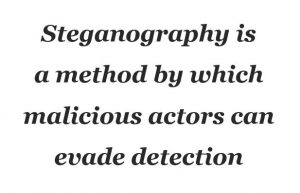Last updated on October 14, 2022

What is Steganography?
Steganography is an old concept which implies “hiding a secret message in an ordinary looking file” which doesn’t bring about any suspicions. The word Steganography is originated from Greek words; “Steganos” which means concealed / protected and “Graphein” that refers to writing.
How does Steganography differ from Cryptography?

In cryptography, you know that the secret message is there and only its content is concealed whereas in steganography, it’s difficult to identify the existence of the secret message.
How does Steganography work?
Herein malicious or secret information is hidden inside apparently harmless files such as images, PDFs, audios, videos and many other types of documents.
When it comes to image files, threat actors are able to use the least significant bits of an image in order to conceal malicious codes. The specialty in here is that the image can look visually unmodified even after modifications being done. This process is known as “steghide”.
For attackers an image is a very good object to hide malicious codes and information. Generally, it does not raise curiosity and it is sometimes challenging for most security tools / anti-malware software to detect those files.
How do we protect from documents / files with Steganography?
- If an image is abnormally large, it could be a hint that steganography was used.
- Educate and raise awareness among your family members / friends / colleagues on this; that apparently harmless files can contain computer viruses.
- Use web filtering for safer browsing and keep up-to-date with latest security patches.
- Businesses can protect against these types of attacks through a solid host based malware detection system.
- Network monitoring can help identifying new steganographically displayed breakdowns.
Sources:
https://www.esecurityplanet.com/threats/how-steganography-allows-attackers-to-evade-detection/
https://www.csoonline.com/article/3632146/steganography-explained-and-how-to-protect-against-it.html

